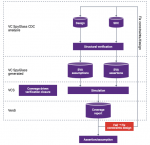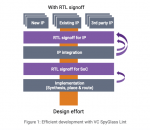You are currently viewing SemiWiki as a guest which gives you limited access to the site. To view blog comments and experience other SemiWiki features you must be a registered member. Registration is fast, simple, and absolutely free so please,
join our community today!
This blog is the next in a series in which Paul Cunningham (GM of the Verification Group at Cadence), Jim Hogan and I pick a paper on a novel idea we appreciated and suggest opportunities to further build on that idea.
We’re getting a lot of hits on these blogs but would like really like to get feedback also.
The Innovation
Our next pick… Read More
As someone who was heavily involved with rules for IP reuse for many years, I have a major sense of déja vu in writing again on the topic. But we (in SpyGlass) were primarily invested in atomic-level checks in RTL and gate-level designs. There’s a higher level of best practices in process we didn’t attempt to cover. ClioSoft just released… Read More
Synopsys just released a white paper, a backgrounder on CDC. You’ve read enough of what I’ve written on this topic that I don’t need to re-tread that path. However, this is tech so there’s always something new to talk about. This time I’ll cover a Synopsys survey update on numbers of clock domains in designs, also an update on ways to… Read More
Mentor just released a white paper on this topic which I confess has taxed my abilities to blog the topic. It’s not that the white paper is not worthy – I’m sure it is. I’m less sure that I’m worthy to blog on such a detailed technical paper. But I’m always up for a challenge, so let’s see what I can make of this, extracting a quick and not very… Read More
It’s a matter of pride to me and many others from Atrenta days that the brand we built in SpyGlass has been so enduring. It seems that pretty much anyone who thinks of static RTL checking thinks SpyGlass. Even after Synopsys acquired Atrenta, they kept the name as-is, I’m sure because the brand recognition was so valuable.
Even good… Read More
I was scheduled to attend the Mentor tutorial at DVCon this year. Then coronavirus hit, two big sponsors dropped out and the schedule was shortened to three days. Mentor’s tutorial had to be moved to Wednesday and, as luck would have it, I already had commitments on that day. Mentor kindly sent me the slides and audio from the meeting… Read More
It seemed we were more or less resigned to Huawei owning 5G infrastructure worldwide. Then questions about security came to the fore, Huawei purchases were put on hold (though that position is being tested outside the US) and opportunity for other infrastructure suppliers (Ericsson, Nokia, etc) has opened up again.
Building … Read More
This blog is the next in a series in which Paul Cunningham (GM of the Verification Group at Cadence), Jim Hogan and I pick a paper on a novel idea we appreciated and suggest opportunities to further build on that idea.
We welcome comments on our blogs and suggestions for new topics if they’re based on published work.
The Innovation
Our… Read More
Security has been a domain blessed with an abundance of methods to improve in various ways, not so much in methods to measure the effectiveness of those improvements. With the best will in the world, absent an agreed security measurement, all those improvement techniques still add up to “trust me, our baby monitor camera is really… Read More
The potential for AI in cars, whether for driver assistance or full autonomy, has been trumpeted everywhere and continues to grow. Within the car we have vision, radar and ultrasonic sensors to detect obstacles in front, behind and to the side of the car. Outside the car, V2x promises to share real-time information between vehicles… Read More










